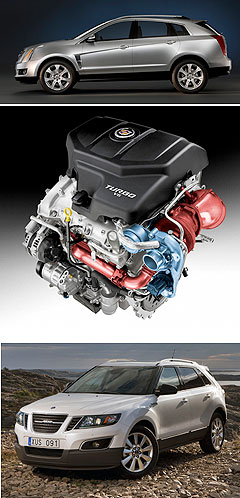News - Cadillac - SRXCadillac puts brakes on Holden turbo V6Not so fast: Cadillac's SRX Turbo has come to the end of the line due to slow sales. Slow sales scuttle turbo Cadillac SRX – and part of Holden's V6 export program4 Jan 2011 CADILLAC’S decision to kill production of the turbo-charged V6 version of its North American SRX mid-sized SUV has closed a niche engine export door for GM Holden. However, the Australian company will continue shipping the 2.8-litre LP9 turbo V6 engine from its Port Melbourne engine plant to Mexico for Saab’s new 9-4X crossover vehicle, which is made alongside its Cadillac twin at GM’s Ramos Arizpe factory. The decision to end production of the high-performance SRX has been blamed on disappointing sales compared with the standard normally aspirated 3.0-litre V6 model, although sales of the turbo headline version will continue through 2011 on stockpiled vehicles. Cadillac spokesperson Robyn Henderson told Autonews that the turbo model comprised only five to 10 per cent of SRX sales since it was launched in December 2009. Cadillac SRX sales are expected to come in at just under 50,000 units for 2010, meaning turbo sales are likely to be between 2500 and 5000 units for the year. Developing 221kW at 5500rpm and 400Nm of torque at 2000rpm, the Holden-made LP9 turbo engine – a variation of Holden’s Commodore V6 – has been criticised for its thirst, delivering just 15.6 litres per 100km in urban driving and 10.6L/100km on the highway cycle. It also ran into trouble last year when a number of vehicles suffered major engine failures after drivers ignored warnings to the contrary and filled up with low-octane fuel in the US.  From top: Cadillac SRX, the Holden-made 2.8-litre turbo V6 and Saab's 9-4X. From top: Cadillac SRX, the Holden-made 2.8-litre turbo V6 and Saab's 9-4X.The troubles forced GM to recall the vehicle to have the engine control unit recalibrated to cope with the dodgy fuel, which can be as low as 88 octane in some states. American reports suggest GM is planning to replace the turbo V6 in the SRX line-up with a hybrid plug-in powertrain, using Volt technology. Confirming the Cadillac decision to cut the V6 turbo from SRX production, Holden corporate communications manager Emma Watts told GoAuto that the decision would have minimal impact on Holden engine production at Port Melbourne and negligible affect on the Holden bottom line. “We are talking very, very minimal numbers of engines here,” she said. “Mike (GM Holden chairman and managing director Mike Devereux) has reiterated through 2010 that we now rely much more heavily on domestic sales rather than export sales, so cancellation of an export program such as this will have a very minimal impact on us.” Ms Watts said the high value of the Australian dollar against the US greenback was not a significant factor in the decision, which, she indicated, came down to sales perfomrance. “In the case of any import or export program we take into account a much longer life cycle of exchange rates,” she said. “I don’t know the exact reason for the cancellation of the vehicle but I am guessing it was based on volume sales of the vehicle rather than the dollar.” As we write, the Australia dollar is worth more than the USD – about 20 per cent higher than most companies plan for. Holden’s Mr Devereux recently said his company did its exchange rate planning using a figure “with an eight in front of it”, indicating a rate in the 80 cents-to-the-USD range. Cadillac SRX’s mainstream engine – the 198kW/302Nm 3.0-litre direct-injection V6 – is supplied from GM’s St Catherines plant in Canada, which also supplies a similar engine for the Saab 9-4X which went on sale overseas in the last quarter of 2010 and is expected in Australia by the fourth-quarter of 2011. Despite the Cadillac decision, the Aero version of the Saab 9-4X is expected to retain the 2.8-litre turbo, which is also exported by Holden to Sweden for the new Saab 9-5 Aero sedan. Saab did the turbo engineering for the engine before the Swedish company was cast adrift in GM’s GFC meltdown. GM Holden exports the 2.8-litre V6 in its hottest 240kW/435Nm form to Europe for the Opel/Vauxhall Insignia flagship, known in the UK as the Insignia VRX and on mainland Europe as Insignia OPC. Normally aspirated variants of Holden’s High Feature V6 are also exported to Thailand, South Korea and China where they are fitted to models such as the Captiva, Colorado, Buick Park Avenue and Daewoo Winstorm. However, exports to Fiat SpA were put on death row last year when the Italian car-maker announced it would switch from the 3.2-litre Holden V6 to Chrysler’s Pentastar V6 under its new partnership arrangements. Holden had supplied a 3.2-litre 191kW version of the Commodore V6 for the Alfa Romeo flagship 159, Brera coupe and Spider sportscar models since 2006.  Read more |
Click to shareCadillac articlesMotor industry news |
















Facebook Twitter Instagram